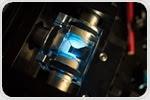|
|
| | July 5, 2018 | |
| | |
| | The latest life science microscopy news from AZoNetwork | |
|
|
 |
| |  Quantitative Biological Imaging at the Single Molecule Level Quantitative Biological Imaging at the Single Molecule Level
While images can be visually impressive and provide qualitative, descriptive information, biological research is increasingly focusing on quantitative measurements.
Such measurements allow scientists to test hypotheses and conduct data driven experiments. This is particularly true for super-resolution localization microscopy, which generates sets of precise molecular location data over a period of time. The resulting data is used to create images, and also allows for direct quantitative analysis of molecular positions in a sample, providing a fundamentally different type of analysis than is possible with image-based techniques like STED and SIM.
A free version of Bruker’s Vutara SRX software is available for download, offering a number of measurement analyses to help researchers quickly and easily analyze the molecular localization data collected. The downloadable file is bundled with a test encrypted data set that allows you to see how SRX can quickly create publication-quality videos, images, and measurements.
| |
|
|
|
|
|
 |
| |
 Inspired by the beauty and breadth of images submitted for Image of the Year 2017, Olympus continues its quest for the best light microscopy art in 2018. For the chance to win a microscope or camera, applicants can now submit life science light microscopy images taken with Olympus equipment. Inspired by the beauty and breadth of images submitted for Image of the Year 2017, Olympus continues its quest for the best light microscopy art in 2018. For the chance to win a microscope or camera, applicants can now submit life science light microscopy images taken with Olympus equipment. | |
|
| |
 A new microscope system can image living tissue in real time and in molecular detail, without any chemicals or dyes, report researchers at the University of Illinois. A new microscope system can image living tissue in real time and in molecular detail, without any chemicals or dyes, report researchers at the University of Illinois. | |
|
| |
 The University of North Florida Materials Science and Engineering Research Facility (MSERF) has partnered with TESCAN, a leading manufacturer of electron and light microscopes, in the installation of one of its new Q-Phase microscopes, a unique instrument for quantitative phase imaging based on holographic microscopy. The University of North Florida Materials Science and Engineering Research Facility (MSERF) has partnered with TESCAN, a leading manufacturer of electron and light microscopes, in the installation of one of its new Q-Phase microscopes, a unique instrument for quantitative phase imaging based on holographic microscopy. | |
|
| |
 Modern microscopy has given scientists a front-row seat to living, breathing biology in all its technicolor glory. But access to the best technologies can be spotty. Jan Huisken, a medical engineering investigator at the Morgridge Institute for Research and co-founder of light sheet microscopy, has a new project meant to bridge the technology gap. Modern microscopy has given scientists a front-row seat to living, breathing biology in all its technicolor glory. But access to the best technologies can be spotty. Jan Huisken, a medical engineering investigator at the Morgridge Institute for Research and co-founder of light sheet microscopy, has a new project meant to bridge the technology gap. | |
|
|
|
|
|







No hay comentarios:
Publicar un comentario